I recently took an incredible picture of a distant galaxy using my backyard telescope. While many of you have seen me do this often on YouTube, this time, the experience was a little different.
The rules of this galaxy photography challenge were simple. I could prepare my camera and telescope equipment beforehand, but I only had one hour to actually take the image.
The clock started ticking as soon as the first exposure began collecting light, and I only had a one-hour time window to work with. All things considered, I think the final image turned out pretty great.
Watch my experience photographing a galaxy in 1 hour on YouTube.
The 1-Hour Astrophotography Challenge
I know that, for many of you, your window of clear-sky imaging time is limited. Between the cloudy skies, full moons, and your day-to-day real-life commitments, a moonless clear night of galaxy photography is incredibly rare.
With that in mind, I thought it would be interesting to share what is possible under relatable conditions in a short amount of time. I captured my image from my increasingly light-polluted backyard (Bortle Scale Class 6), with a nearly full moon rising soon after dark.
However, I used some simple strategies, both in terms of the equipment I used and my approach, to overcome these conditions. While these may seem obvious to experienced astrophotographers, these simple precautions can increase your success rate.
- Choose a target in the darkest direction of your backyard sky
- Keep the timing, phase, and position of the moon in mind
- Use a custom landscape in Stellarium to avoid obstructions
- Browse AstroBin for a rough idea of the amount of exposure time needed
Using these planning strategies, my deep-sky target selections were narrowed down to constellations in the western sky. This area is full of smaller galaxies such as the Needle Galaxy, M106, and the Whale Galaxy.
I use the Stellarium desktop software with a custom landscape to plan my astrophotography images.
A Telescope For Galaxy Photography
One of the best ways to maximize your limited clear sky time is to use an astrophotography telescope with ‘fast’ optics. Generally, this means an optical tube with a focal ratio of F/4 or below.
The Newtonian reflector telescope type is a popular choice for amateur astrophotographers. It offers the best ‘bang for your buck’ in terms of light-gathering power. To collect even more light, I used a specialized reducer/corrector lens to bring my reflector telescope down to F/3.
While I normally prefer to use an apochromatic refractor telescope for deep-sky astrophotography, the large aperture and fast focal ratio of this reflector telescope have some serious advantages for galaxy photography. I call this telescope ‘the difference maker’. It helps me collect as much starlight as possible in a short amount of time.
The astrophotography kit I used for this project is pretty similar to the one I used to photograph the Whirlpool Galaxy about a month ago (when I used this reflector telescope for the first time). I realize that it’s not exactly entry-level astrophotography equipment, but the process I used can be scaled down to a more modest setup.
The Sky-Watcher Quattro 300P shoots at a native focal length of 1200mm at F/4.
The camera I used was a ZWO ASI294MC Pro, a one-shot-color dedicated astronomy camera with an 11.7 MP CMOS sensor. To capture an image with better contrast, I placed a 2-inch light pollution filter (Optolong L-Quad Enhance) in front of the camera sensor. Using the Starizona Nexus Coma Corrector/Reducer, I converted the telescope specs from 1200mm at F/4 to 900mm at F/3.
Choosing a Galaxy to Photograph
Using Stellarium, I filtered the deep-sky objects that appeared in the software down to galaxies that were magnitude 10 or brighter (the lower the number, the brighter the galaxy). Then, I isolated the results that appeared in the western portion of my backyard sky to avoid shooting into my city’s ‘light dome’.
This provided a handful of deep-sky astrophotography targets that I would consider to be ‘out of season’ as they fade further into the western horizon each night. There were a few noteworthy galaxies in this area, including M106 and the Whirlpool Galaxy in Canes Venatici.
When I found a potential candidate, I cross-referenced the target in AstroBin to see several examples of the target. This allowed me to see just how many hours the photographer used to create the image. If a target required 20+ hours of total exposure time to capture properly, it was likely not a great choice for the 1-hour challenge.
After much deliberation, I decided to photograph the Whale Galaxy in the constellation Canes Venatici (Magnitude 9.2). It’s a barred spiral galaxy that lies approximately 30 million light-years away from Earth. I’ve photographed this galaxy many times before, but never with a large reflector telescope.
My Newtonian Reflector Telescope collecting light over a 1-hour period in the backyard.
My Galaxy Photography Results (in 1 Hour)
Having the telescope already polar aligned, balanced, and ready to go saved me a lot of setup time. All I had to do was focus the camera on a star next to the Whale Galaxy using the live-view focus tool on the ASIAIR Plus mobile app. I also utilized the autoguiding feature on the ASIAIR for improved tracking performance and ensured that the ‘dithering‘ feature was turned on.
After my imaging session was over, I took calibration frames, including dark frames, bias frames, and flat frames. Since these could be taken in the house during the day (at any time), I think it’s fair not to include them in the one-hour imaging window.
I ended up capturing 20 x 3-minute exposures on the Whale Galaxy, a full 60 minutes in total. Technically, I went over the one-hour time limit as I didn’t account for the fact that the timestamp on the first sub-exposure listed when the first exposure ended, not began.
I registered, stacked, and calibrated the individual sub-frames using the WBPP (weighted batch pre-processing) script in PixInsight. This is my image-stacking software of choice lately, but there are many other free stacking tools, such as DeepSkyStacker. The final image processing was done using a combination of PixInisght and Adobe Photoshop.
The Whale Galaxy (NGC 4631) in Canes Venatici. (1 Hour Total Exposure).
A close-up of the Whale Galaxy from my final image (cropped).
As you can imagine, noise reduction was a key step toward producing a presentable image of a galaxy using only 1 hour of total exposure time. The advanced noise reduction tools in Adobe Camera Raw (especially the color noise reduction) were incredibly handy for this project.
I hope that this experience has inspired you to take on a deep-sky astrophotography project when time is short. With a little planning and preparation, you can increase your chances of producing an exciting photo of a galaxy or nebula from your backyard this summer.
Trevor Jones is a deep-sky astrophotographer and a valued member of the RASC. His passion is to inspire others to start their astrophotography journey on his YouTube Channel, so they can appreciate the night sky as much as he does. His images have been featured in astronomy books and online publications, including the NASA Astronomy Picture of the Day (APOD).
is a deep-sky astrophotographer and a valued member of the RASC. His passion is to inspire others to start their astrophotography journey on his YouTube Channel, so they can appreciate the night sky as much as he does. His images have been featured in astronomy books and online publications, including the NASA Astronomy Picture of the Day (APOD).
Related Posts:












